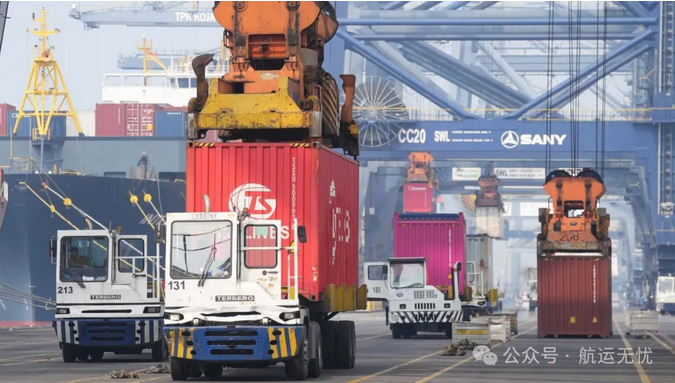The Sino-US Trade Storm is Back: Top 10 Recommendations for Chinese Enterprises under "Reciprocal Tariffs" | Maritime Export Logistics
Apr 11,2025

On the stage of global trade, a "tariff storm" set off by the Trump administration in the United States erupted in April 2025.
On April 2, Trump signed two "reciprocal tariffs" executive orders at the White House, instantly becoming the focus of global attention and plunging the international trade landscape into turmoil.
I. US "reciprocal tariffs": the "blockbuster bomb" in the trade chess game This policy resorts to a two-tier architecture of "benchmark tariffs + additional tariffs."
The 10% benchmark tariff, which will apply to all trading partners as a unified threshold from April 5, 2025, replaces the previous system of scattered tax rates.
And for the 60 economies with large trade deficits, the U.S. did not budge, imposing a higher tax rate that took effect on April 9.
China bore the brunt, being hit with a 34 percent additional tariff, which, combined with 20 percent earlier due to fentanyl, soared to 54 percent. The European Union, Vietnam, Japan, India, South Korea and other economies have also been "hit" by tariffs to varying degrees, and global trade routes have been clouded for a time.
II. The Chinese government's strong counter-attack: fighting multiple punches to defend rights and interests In the face of the US move, the Chinese government resolutely sharpened its sword and took a beautiful "combo" of punches at the earliest time:
1. Tariff countermeasures: From 12.01 a.m. on April 10, the Customs and Excise Service Committee of the State Council announced that a tariff of 34% would be imposed on imports originating in the United States on the basis of the current applicable tariff rate, and the current policy of tax protection and tax relief would remain unchanged, and the additional tariffs would not be waived.
At the same time, it was made clear that goods imported during certain periods of time could be exempted from the tariff increase by 12 a.m. on April 10, demonstrating both a tough attitude and a reasonable buffer.
2. Rare earth control: On April 4, pursuant to the Export Control Law of the People's Republic of China, The Ministry of Commerce and the General Administration of Customs impose export controls on seven categories of heavy rare earths related items such as sodium, ruthenium, ruthene, tritium, nickel, and yttrium. Rare earths are strategic resources, and this move hits the "vital" of the US high-tech industry, leaving its key sector development facing the spectre of "food cuts."
3. Entities controlled: Also on April 4, the Commerce Department placed 16 U.S. entities on an export control and control list, banning the export of dual-use items to them, such as High Point Aerospace Technology and Universal World Logistics, which strikes a precise blow to the U.S advantage in aviation, logistics and other fields. Meanwhile, 11 U.S. companies have been added to the list of "unreliable entities," banning new investment in China and restricting import and export activities, hindering their business placement in China.
4. Industrial investigation: For the import of medical CT tubes, the Ministry of Commerce officially launched an anti-dumping investigation to prop up the "umbrella" for domestic related industries to resist the impact of unfair competition of imported products.
Third, China's export enterprises' self-help guide: contract "military strategy" to resolve the crisis In this turbulent wave of trade, China's export enterprises are like sailing in the waves, and they must use contract drafting as the "sea-splitting needle" to stabilize their position. Here are ten "wonderful plans" that enterprises can refer to:
1. Clarify tariff responsibilities to avoid disputes over costs: In international trade contracts, it is crucial to clearly state the party responsible for tariffs. If a product has a unique high-tech advantage and is irreplaceable in overseas markets, enterprises can learn from Kunshan Yaxiang Fragrance Co., Ltd. and take the initiative to bear the DDP (Delivered Duty Paid) flag, clearly writing the details of price adjustments into the contract. For enterprises quoting FOB (Free On Board) and EXW (Ex Works), it is especially important to note that while tariffs are usually borne by the US buyer under normal circumstances, to prevent disputes in the future, they must be confirmed again in the contract. Under the FOB trade term, the seller is responsible for loading the goods onto the ship, and once the goods have crossed the ship's rail, the risk and costs are transferred to the buyer, and tariffs are usually paid by the buyer. Under the EXW trade term, the seller prepares the goods at the designated location, and subsequent transportation and tariffs are borne by the buyer. Considering the significant increase in tariffs, if both parties agree to share the responsibility, the proportion and payment method of sharing should be clearly agreed upon to avoid disputes in the future.
2. Skillfully set price adjustments to deal with soaring costs: Set up a price adjustment mechanism in the contract, just like putting on a "protective suit" for the enterprise. For example, it is agreed that: "If the cost increase due to the adjustment of US tariff policy exceeds 10%, the two parties will negotiate the price within 30 days. The contract will continue to be valid during the negotiation period, and the price adjustment will be retroactive to the date of the tariff's entry into force. If they cannot reach an agreement, the export price will be automatically increased by [X]%." The terms are clearly defined and operable, and the trigger conditions, calculation methods, effective time, and negotiation mechanism must not be missing. In this way, when facing tariff changes, the interests of both parties are guaranteed, and commercial risks and legal disputes will naturally be reduced.
3. Plan the delivery time and control the order risk: According to the US "equivalent tariff" exemption period, reasonably arrange the delivery nodes, and the contract stipulates: "The seller ensures that the goods are shipped from the starting point before 12:01 on April 10, 2025, and enjoy tariff exemption." If you miss this "tax exemption bus," the responsibilities and remedies of both parties must be determined in advance. Moreover, considering that the buyer may cancel the order or delay payment, the enterprise can require a deposit of 30% to 50% of the advance payment, shorten the payment to 7 days after the bill of lading, and specify "the buyer cancels the order due to tariff policy, the deposit is not refunded," adding a "safety lock" for itself.
4. Prepare contingency plans to mitigate policy changes: Include provisions in international trade contracts to address changes in tariff policies, such as: "In the event of a significant change in the U.S. tariff policy during the term of the contract, the parties shall negotiate a solution within 15 working days." At the same time, clearly define the exemptions for contracts that are difficult to fulfill due to tariff policies, introduce force majeure clauses, and include "unilateral sanctions by the U.S. government" and "the extension of customs examination due to trade disputes between China and the United States" in the scope of force majeure, and refine it according to the differences in laws between China and the United States, and agree on a grace period with the buyer to avoid falling into a "pit" when fulfilling the contract.
5. Strictly adhere to the certificate of origin and avoid the risk of verification: Recently, the United States is likely to strictly check the origin of Chinese goods to prevent tax evasion through transshipment trade. Chinese export enterprises must ensure that the certificate of origin is accurate and complete, including Form A certificate, General System of Preferences (GSP) certificate, and Free Trade Agreement (FTA) certificate. These are the "passports" for enjoying tariff preferences. After being issued by the customs or the Chamber of Commerce and Industry, they must specify the raw materials, production process, and final product. Only then can the product pass smoothly.
6. Optimize the application of law and choose the right dispute adjudicator: The contract clearly applies Chinese law, which provides stronger protection for the interests of exporters. Dispute resolution should prioritize the China International Economic and Trade Arbitration Commission (CIETAC), which has sufficient arbitration experience and a good reputation. Its decisions are unimpeded in more than 140 member countries of the New York Convention. If both parties have concerns, the Singapore International Arbitration Centre (SIAC) is also a good option. Both are known for their fairness and efficiency, providing protection for the resolution of trade disputes for enterprises.
7. Understand the buyer's credit and reduce the risk of cooperation: Before "handing over" to the American buyer, a comprehensive credit investigation must not be lacking. By using professional rating agencies such as Standard & Poor's, Moody's, and Fitch, we can understand the buyer's financial situation, credit, market reputation, transaction records, and the economic and political environment of the country where the buyer is located. We can clear the minefield in advance and make the cooperation more stable.
8. Strengthen compensation for breach of contract and safeguard the right to receive payment: The mechanism for compensation for breach of contract should be clearly defined in international trade contracts. Take the late payment penalty clause as an example: "If the buyer fails to pay the purchase price on time, a late payment penalty of [X]% of the unpaid amount will be paid for each day of delay. The late payment penalty = unpaid amount × [X]% × number of days of delay. The late payment penalty will be paid to the seller together with the payment." The clause is clear and enforceable. The scope of breach, calculation method, and standard should be checked by professional foreign-related lawyers to ensure that there are no worries about receiving payment.
9. Flexible payment adjustment to suit the buyer's credit: Flexibly adjust the payment terms according to the buyer's credit rating in the United States. If the buyer's credit rating is poor, require advance payment and shorten the credit period; establish credit risk early warning, and if the buyer has any financial crisis signals, such as requesting a delay in payment or cutting the price for quality reasons, the enterprise will immediately start risk control to reduce losses.
10. Keep a close eye on the list of exemptions and seize export opportunities: the list of US tariff exemptions is a "treasure map" for enterprises. Regularly check the official website of the Office of the United States Trade Representative (USTR), form a professional team, compare the customs code (HTS) of the goods with the list in detail, and screen the key points: verify the sub-category of HTSUS, confirm the scope of exemption, timely declare the effective date of exemption, and apply for pre-determination when it is difficult to determine the tax number. The declaration builds a triple proof: basic legal documents, customs declaration documents, and supplementary evidence materials. The contract marks the product code and the exemption situation, so that the export enjoys preferential treatment and avoids risks.
IV. The "reshaping" of the global supply chain: challenges and opportunities coexist The U.S. "reciprocal tariff" policy is like a huge stone thrown into the global supply chain lake, causing a thousand waves.
In the long run, the export and supply chain of major manufacturing countries such as China and Southeast Asia will be forced to be reshaped, the global monetary system will be shaken and unstable, and the soft power of the United States will be weakened. The trade pattern will face a deep reshuffle. However, export-oriented manufacturing enterprises in China do not need to be discouraged. By understanding the trend of policies and using clever strategies, they can find new opportunities in difficulties and seek development in challenges.
In short, as long as China's export enterprises make good use of strategies such as contract optimization, risk management, and customer communication, they will be able to ride the storm of the United States' "reciprocal tariffs" and defend their own rights and interests, sailing steadily in the vast sea of international trade. May this article light up a lamp for enterprises and illuminate the way ahead.

Make global trade unimpeded
Contact Phone


Contact Us
Copyright ©Guangzhou Hongdex International Logistics Co.,Ltd
Hotline: 020-84608598
Whatsapp: 18011705178
QQ:2853396538
Email: 2853396545@qq.com
We will provide you with timely feedback











